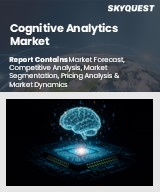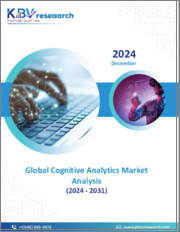
|
시장보고서
상품코드
1802005
세계의 인지 분석 시장 규모, 점유율, 성장 분석 : 유형별, 용도별, 최종사용자별, 지역별 - 산업 예측(2025-2032년)Cognitive Analytics Market Size, Share, and Growth Analysis, By Type (On-Premises, Cloud-Based), By Application (Fraud Detection, Customer Insights), By End-User, By Region - Industry Forecast 2025-2032 |
||||||
세계의 인지 분석 시장 규모는 2023년에 39억 달러로 평가되며, 2024년 51억 2,000만 달러에서 2032년에는 449억 2,000만 달러로 성장하며, 예측 기간(2025-2032년)의 CAGR은 31.2%로 성장할 전망입니다.
세계 인지 분석 시장은 다양한 산업 분야에서 데이터베이스 의사결정에 대한 요구가 증가함에 따라 강력한 성장세를 보이고 있습니다. 조직은 복잡한 데이터 패턴을 이해하고, 이를 통해 학습하고, 적응할 수 있는 첨단 지능형 시스템을 요구하고 있습니다. 머신러닝, 자연 언어 처리, 실시간 데이터 분석의 중요성이 커지면서 헬스케어, 금융, 소매, 제조 등의 분야에서 인지 분석을 활용하여 업무 효율성을 높이고 고객에 대한 심층적인 인사이트를 확보하는 것이 이 시장의 주요 촉진요인입니다. 클라우드 기반 플랫폼과의 통합을 통해 이러한 기술에 대한 액세스가 더욱 간소화되었습니다. 알고리즘, 딥러닝, 그래프 분석의 혁신으로 시스템이 비정형 데이터를 효율적으로 처리할 수 있게 되었고, 인메모리 컴퓨팅과 시각화 툴의 발전으로 사용 편의성이 향상되었으며, 비즈니스 사용자는 고급 분석에서 실행 가능한 인사이트를 빠르게 도출할 수 있게 되었습니다. 빠르게 인사이트를 도출할 수 있게 되었습니다.
목차
서론
- 조사의 목적
- 조사 범위
- 정의
조사 방법
- 정보 조달
- 2차·1차 정보원
- 시장 규모 예측
- 시장의 전제조건과 제한
개요
- 세계 시장 전망
- 공급과 수요 동향 분석
- 부문별 기회 분석
시장 역학과 전망
- 시장 개요
- 시장 규모
- 시장 역학
- 촉진요인과 기회
- 억제요인과 과제
- Porter의 산업 분석
주요 시장 인사이트
- 주요 성공 요인
- 경쟁의 정도
- 주요 투자 기회
- 시장 에코시스템
- 시장의 매력 지수(2024년)
- PESTEL 분석
- 거시경제 지표
- 밸류체인 분석
- 가격 분석
- 사례 연구
인지 분석 시장 규모 : 유형별, CAGR(2025-2032년)
- 시장 개요
- 온프레미스
- 클라우드 기반
- 하이브리드
인지 분석 시장 규모 : 용도별, CAGR(2025-2032년)
- 시장 개요
- 부정행위 탐지
- 고객 인사이트
- 리스크 관리
- 예지보전
인지 분석 시장 규모 : 최종사용자별, CAGR(2025-2032년)
- 시장 개요
- 헬스케어
- 소매
- 은행 및 금융 서비스
- 제조
- 기타
인지 분석 시장 규모, CAGR(2025-2032년)
- 북미
- 미국
- 캐나다
- 유럽
- 독일
- 스페인
- 프랑스
- 영국
- 이탈리아
- 기타 유럽
- 아시아태평양
- 중국
- 인도
- 일본
- 한국
- 기타 아시아태평양
- 라틴아메리카
- 브라질
- 기타 라틴아메리카
- 중동 및 아프리카
- GCC 국가
- 남아프리카공화국
- 기타 중동 및 아프리카
경쟁 정보
- 상위 5사의 비교
- 주요 기업의 시장 포지셔닝(2024년)
- 주요 시장 기업이 채택한 전략
- 최근 시장 동향
- 기업의 시장 점유율 분석(2024년)
- 주요 기업 개요
- 기업의 상세
- 제품 포트폴리오 분석
- 기업의 부문별 점유율 분석
- 매출의 전년대비 비교(2022-2024년)
주요 기업 개요
- IBM Corporation(USA)
- Cisco Systems Inc.(USA)
- Microsoft Corporation(USA)
- Oracle Corporation(USA)
- SAS Institute(USA)
- Google LLC(USA)
- Intel Corporation(USA)
- Hewlett Packard Enterprise(USA)
- Cognizent(USA)
- TIBCO Software(USA)
- MicroStrategy(USA)
- Palantir Technologies(USA)
- Accenture(Ireland)
- Clarifai(USA)
결론과 제안
KSA 25.09.09Global Cognitive Analytics Market size was valued at USD 3.9 billion in 2023 and is poised to grow from USD 5.12 billion in 2024 to USD 44.92 billion by 2032, growing at a CAGR of 31.2% during the forecast period (2025-2032).
The global cognitive analytics market is witnessing robust growth, fueled by the increasing need for data-driven decision-making across diverse industries. Organizations seek advanced intelligent systems capable of comprehending, learning from, and adapting to complex data patterns. The rising significance of machine learning, natural language processing, and real-time data analysis are key drivers of this market, with sectors such as healthcare, finance, retail, and manufacturing leveraging cognitive analytics to enhance operational efficiency and gain deeper customer insights. Integration with cloud-based platforms is further simplifying access to these technologies. Innovations in algorithms, deep learning, and graph analytics are enabling systems to process unstructured data effectively, while advancements in in-memory computing and visualization tools are enhancing usability, allowing business users to derive actionable insights swiftly from sophisticated analytics.
Top-down and bottom-up approaches were used to estimate and validate the size of the Global Cognitive Analytics market and to estimate the size of various other dependent submarkets. The research methodology used to estimate the market size includes the following details: The key players in the market were identified through secondary research, and their market shares in the respective regions were determined through primary and secondary research. This entire procedure includes the study of the annual and financial reports of the top market players and extensive interviews for key insights from industry leaders such as CEOs, VPs, directors, and marketing executives. All percentage shares split, and breakdowns were determined using secondary sources and verified through Primary sources. All possible parameters that affect the markets covered in this research study have been accounted for, viewed in extensive detail, verified through primary research, and analyzed to get the final quantitative and qualitative data.
Global Cognitive Analytics Market Segments Analysis
Global Cognitive Analytics Market is segmented by Type, Application, End-User and region. Based on Type, the market is segmented into On-Premises, Cloud-Based and Hybrid. Based on Application, the market is segmented into Fraud Detection, Customer Insights, Risk Management and Predictive Maintenance. Based on End-User, the market is segmented into Healthcare, Retail, Banking and Financial Services, Manufacturing and Others. Based on region, the market is segmented into North America, Europe, Asia Pacific, Latin America and Middle East & Africa.
Driver of the Global Cognitive Analytics Market
The Global Cognitive Analytics market is primarily propelled by the swift advancements in artificial intelligence and machine learning technologies, which yield substantial benefits across various sectors. These innovations enhance the ability to recognize intricate patterns through an in-depth understanding of contextual data, while also allowing for remarkably adaptive learning processes. As a result, organizations can extract deeper insights from intricate datasets, significantly improving the speed of automated decision-making and increasing predictive accuracy. This evolution leads to transformative impacts on operational efficiency and effectiveness, making cognitive analytics an essential component for businesses aiming to thrive in an increasingly data-driven world.
Restraints in the Global Cognitive Analytics Market
The global cognitive analytics market faces significant challenges due to rising concerns surrounding data privacy and protection. The nature of cognitive analytics involves handling sensitive personal information, which heightens the risk of potential data breaches and abuse by malicious entities. Stricter data protection regulations impose severe restrictions on data access and utilization, creating obstacles for widespread implementation. These limitations are particularly pronounced in heavily regulated industries such as healthcare, where compliance with stringent laws is paramount. Consequently, these factors collectively hinder the growth and adoption of cognitive analytics solutions on a global scale, causing notable delays in market expansion efforts.
Market Trends of the Global Cognitive Analytics Market
The Global Cognitive Analytics market is witnessing a significant shift towards the development of industry-specific solutions, catering to sectors such as healthcare, finance, and manufacturing. These tailored cognitive analytics platforms address unique regulatory requirements, business challenges, and data complexities, delivering more pertinent insights and enhanced performance tailored to each industry. This focused approach facilitates quicker implementation, improved return on investment, and seamless integration into existing workflows, thereby accelerating the growth and adoption of cognitive analytics technologies across various markets. As organizations increasingly recognize the importance of specialized analytics, this trend is set to redefine how data-driven decision-making is approached in diverse sectors.
Table of Contents
Introduction
- Objectives of the Study
- Scope of the Report
- Definitions
Research Methodology
- Information Procurement
- Secondary & Primary Data Methods
- Market Size Estimation
- Market Assumptions & Limitations
Executive Summary
- Global Market Outlook
- Supply & Demand Trend Analysis
- Segmental Opportunity Analysis
Market Dynamics & Outlook
- Market Overview
- Market Size
- Market Dynamics
- Drivers & Opportunities
- Restraints & Challenges
- Porters Analysis
- Competitive rivalry
- Threat of substitute
- Bargaining power of buyers
- Threat of new entrants
- Bargaining power of suppliers
Key Market Insights
- Key Success Factors
- Degree of Competition
- Top Investment Pockets
- Market Ecosystem
- Market Attractiveness Index, 2024
- PESTEL Analysis
- Macro-Economic Indicators
- Value Chain Analysis
- Pricing Analysis
- Case Studies
Global Cognitive Analytics Market Size by Type & CAGR (2025-2032)
- Market Overview
- On-Premises
- Cloud-Based
- Hybrid
Global Cognitive Analytics Market Size by Application & CAGR (2025-2032)
- Market Overview
- Fraud Detection
- Customer Insights
- Risk Management
- Predictive Maintenance
Global Cognitive Analytics Market Size by End-User & CAGR (2025-2032)
- Market Overview
- Healthcare
- Retail
- Banking and Financial Services
- Manufacturing
- Others
Global Cognitive Analytics Market Size & CAGR (2025-2032)
- North America (Type, Application, End-User)
- US
- Canada
- Europe (Type, Application, End-User)
- Germany
- Spain
- France
- UK
- Italy
- Rest of Europe
- Asia Pacific (Type, Application, End-User)
- China
- India
- Japan
- South Korea
- Rest of Asia-Pacific
- Latin America (Type, Application, End-User)
- Brazil
- Rest of Latin America
- Middle East & Africa (Type, Application, End-User)
- GCC Countries
- South Africa
- Rest of Middle East & Africa
Competitive Intelligence
- Top 5 Player Comparison
- Market Positioning of Key Players, 2024
- Strategies Adopted by Key Market Players
- Recent Developments in the Market
- Company Market Share Analysis, 2024
- Company Profiles of All Key Players
- Company Details
- Product Portfolio Analysis
- Company's Segmental Share Analysis
- Revenue Y-O-Y Comparison (2022-2024)
Key Company Profiles
- IBM Corporation (USA)
- Company Overview
- Business Segment Overview
- Financial Updates
- Key Developments
- Cisco Systems Inc. (USA)
- Company Overview
- Business Segment Overview
- Financial Updates
- Key Developments
- Microsoft Corporation (USA)
- Company Overview
- Business Segment Overview
- Financial Updates
- Key Developments
- Oracle Corporation (USA)
- Company Overview
- Business Segment Overview
- Financial Updates
- Key Developments
- SAS Institute (USA)
- Company Overview
- Business Segment Overview
- Financial Updates
- Key Developments
- Google LLC (USA)
- Company Overview
- Business Segment Overview
- Financial Updates
- Key Developments
- Intel Corporation (USA)
- Company Overview
- Business Segment Overview
- Financial Updates
- Key Developments
- Hewlett Packard Enterprise (USA)
- Company Overview
- Business Segment Overview
- Financial Updates
- Key Developments
- Cognizent (USA)
- Company Overview
- Business Segment Overview
- Financial Updates
- Key Developments
- TIBCO Software (USA)
- Company Overview
- Business Segment Overview
- Financial Updates
- Key Developments
- MicroStrategy (USA)
- Company Overview
- Business Segment Overview
- Financial Updates
- Key Developments
- Palantir Technologies (USA)
- Company Overview
- Business Segment Overview
- Financial Updates
- Key Developments
- Accenture (Ireland)
- Company Overview
- Business Segment Overview
- Financial Updates
- Key Developments
- Clarifai (USA)
- Company Overview
- Business Segment Overview
- Financial Updates
- Key Developments














